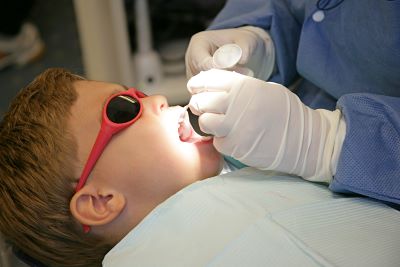Enter your email to receive the CareQuest newsletter:
November 12, 2024

Minimally invasive dentistry (MID) is a philosophy of care that emphasizes prevention and seeks to preserve as much healthy tooth structure as possible. And it’s growing in popularity.

In a recent CareQuest Institute webinar, “Innovative Pediatric Dental Care: Exploring Minimally Invasive Procedures,” panelists described their approach to MID, specifically for pediatric patients. They discussed important tools such as fluoride, silver diamine fluoride (SDF), glass ionomer applications, and Hall crowns, as well as effective communication strategies.

“[I learned some] great options for arresting/restoring primary teeth,” one attendee shared after the webinar. “It’s so much less traumatizing to a child.”
Elizabeth Powell, DDS, MPH, assistant professor, Clinical Pediatric Dentistry and Community Oral Health, University of Pennsylvania School of Dental Medicine, moderated the webinar, which drew more than 600 learners. The presenters were both professors and pediatric dental providers:
- Sofía Iribarren, DDS, MS, assistant professor, University of Nebraska Medical Center
- Jean Star, DDS, MPH, assistant professor of Clinical Orofacial Sciences, Pediatric Dentistry, University of California San Francisco

The presentations were followed by a lively Q&A session that primarily focused on SDF, which can arrest caries lesions but can also permanently stain teeth.
“Excellent presentation and Q&A session,” another attendee shared. “Hats off to the presenters and facilitators.”
Below, we’ve provided an edited summary of the questions and answers. (Note: You can view the full webinar, including the Q&A, in the CareQuest Institute webinar library.)
Can you explain how the SDF interacts with the teeth to arrest caries?
The silver component has a direct bactericidal effect interfering with bacteria metabolism while fluoride is present in sufficient concentration to promote remineralization.
- Can you apply SDF to teeth that present with moderate to severe caries?
You can use SDF on any teeth. However, we do not want to apply SDF to a large carious lesion that may be into the pulp and so it is not advisable to apply SDF to teeth that have necrosis or irreversible pulpitis. That usually means teeth that have spontaneous pain or signs of infection.
For moderate to severe caries, you can use the SMART technique (silver modified atraumatic restorative technique). This involves applying the SDF, which will arrest and kill the germs, and then placing the glass ionomer on top of the SDF. The glass ionomer seals off the caries, so that food and germs cannot get stuck there. The combination of SDF and glass ionomer is the best way to treat moderate to severe caries that do not cause pain.
- What do I need to worry about when it comes to staining and SDF?
SDF stains some things permanently — caries, clothing, the countertop in your office. SDF does not stain the gingiva or healthy tooth structure.
SDF can stain skin, but not permanently. It takes about a week to fade. If a patient is squirming a lot, you can apply a little layer of Vaseline around the child’s extra-oral area to serve as a barrier and prevent staining. If the SDF does stain the skin, parents can remove it by rubbing it with a salt scrub at home.
- How important is isolation in maintaining a dry field for SDF? Is it still effective if I can’t keep it dry?
It’s more effective if you can keep it dry. The goal is to increase the concentration of SDF liquid in the area. If you have SDF mixed with saliva around the tooth, the SDF will be diluted. If you’re able to insert cotton rolls and keep the area dry, then there’s a high concentration of SDF liquid in the area.
However, with some young children who have trouble staying still, that can be difficult. Just do your best. It can still be effective even if it’s less dry.
- Do you recommend that primary care providers apply fluoride varnish during well-child visits to promote early intervention and prevention in the medical setting, especially since children see the pediatrician much more than they see the dentist?
Absolutely. In addition to applying the varnish, pediatricians can talk about oral hygiene instruction and introduce parents to concepts like the importance of diet for oral health. There are continuing education (CE) courses for medical providers that discuss dental integration in the medical setting. One popular example is Smiles for Life.
- If we perform a sealant on an incipient occlusal lesion, will the cavity be arrested?
Yes, sealed incipient caries become arrested (inactive) once the bacteria are starved of the carbohydrate substrate necessary to get worse/deeper.
- Do you have to continually apply SDF like biannual fluoride?
The American Dental Association (ADA) published guidelines regarding the effectiveness of silver diamine fluoride (SDF) for treating cavitated lesions on coronal and root surfaces. Research involving primary teeth demonstrated that applying 38% SDF twice a year is more effective at arresting advanced cavitated lesions compared to applying 5% sodium fluoride (NaF) varnish weekly for three weeks.
Additionally, 38% SDF applied once a year is less effective than the biannual treatment. The ADA recommends using 38% SDF biannually as the first line of care for arresting carious lesions in primary teeth. Furthermore, the ADA has extrapolated these findings to suggest that 38% SDF may also be beneficial for treating advanced cavitated lesions in adult teeth.
- Are 3 to 4 applications of SDF per year any more effective than 2 applications?
The effectiveness of one-time SDF application in arresting dental caries ranges from 47% to 90%, depending on the size of the lesion. However, reapplication may be necessary to sustain arrest. Increasing frequency of application can increase caries arrest rate.
Biannual application of SDF increased the rate of caries lesion arrest compared to annual application. Some studies revealed that three applications per year led to higher arrest rates. Frequency of application after baseline has been suggested at three-month follow-up, and then semiannual recall visits over two years. If the setting allows, monitor caries lesion arrest after a two-to-four-week period and consider reapplication as necessary to achieve arrest of all targeted lesions. Provide re-care monitoring based on patient’s disease activity and caries risk level (every three, four, or six months).
- At what level of cavity progression is it not appropriate to place a restoration over an active caries lesion?
Dental school drills that all decay must be removed before placing a permanent restoration. Management of dental caries should include identification of an individual’s risk for caries progression, understanding of the disease process for that individual, and active surveillance to assess disease progression and intervention with appropriate preventive services, supplemented by restorative therapy when indicated.
Decisions for when to restore caries lesions should include, at the least, clinical criteria of visual detection of enamel cavitation, visual identification of shadowing of the enamel, or radiographic recognition of progression of lesions.
For more definitive guidance on managing deep caries lesions, please reference the AAPD Pediatric Dentistry Restorative Dentistry Best Practices.
- Is it okay to recommend the second dose of SDF in three months instead of six months?
Yes, although the impact of SDF on cavitated lesions and primary teeth is well established, evidence that application of 38% SDF is effective for preventing new smooth surface lesions is increasing.
- Is it necessary to use cavity conditioner when implementing the SMART technique?
Yes. The conditioner helps with increased retention for the glass ionomer. However, it’s better not to apply the conditioner directly after the SDF. If you apply the SDF and glass ionomer on the same day, there’s also the possibility that the glass ionomer will stain; it can turn the restoration in the tooth a grayish color.
The ideal process is to apply the SDF, then schedule a return appointment (any time from the next day to a month later). At the follow-up appointment, isolate, apply the conditioner, rinse it, gently dry but don’t desiccate, and then fill the hole with the glass ionomer.
Editor’s note: You can view the full webinar, including the Q&A, in the CareQuest Institute webinar library.